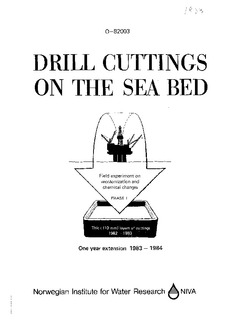| dc.contributor.author | Bakke, T. | nb_NO |
| dc.contributor.author | Green, N. | nb_NO |
| dc.contributor.author | Næs, K. | nb_NO |
| dc.contributor.author | Pedersen, A. | nb_NO |
| dc.contributor.author | Sporstøl, S. | nb_NO |
| dc.contributor.author | Oreld, F. | nb_NO |
| dc.contributor.other | Bakke, T. - Project manager | nb_NO |
| dc.coverage.spatial | Hordaland | nb_NO |
| dc.coverage.temporal | 1983-1984 | nb_NO |
| dc.date.accessioned | 2014-08-01T08:24:17Z | |
| dc.date.available | 2014-08-01T08:24:17Z | |
| dc.date.issued | 1986 | nb_NO |
| dc.identifier | 1833 | nb_NO |
| dc.identifier.isbn | 82-577-1039-3 | nb_NO |
| dc.identifier.issn | 1894-7948 | nb_NO |
| dc.identifier.uri | http://hdl.handle.net/11250/204390 | |
| dc.description.abstract | Cuttings from drilling with water based mud (WBM-cuttings), low aromatic oil based (LAC-cuttings, a first generation low toxic mud), diesel oil based mud (DOX-cuttings) and diesel oil based mud compressed into solid briquettes (BRI-cuttings) were placed in 10 mm thick layers on top of 12 cm natural sea bed sediment in 1x1x0,24 m trays. The trays were left on the sea bed, 11 m, for 2 years. During the second year no further loss in total hydrocarbons or aromatic hydrocarbons (NPD) was detected. Indication of biological degradation of the oil was found after 15 months, and even more so after 24 months. Benthic fauna recolonization clearly distinguished oiled from nonoiled substrates during the first year and this was even more pronounced the second year. Fauna development in reference sand and WBM cuttings was considered normal, whereas the poor fauna of the LAC, BRI and DOC cuttings collapsed completely the second year. No sign of fauna recovery from the discharge was detected after 2 years, irrespective of the type of base oil on the cuttings | nb_NO |
| dc.description.sponsorship | Mobil Exploration Norway Inc. on behalf of the Statfjord Unit Owners | nb_NO |
| dc.publisher | Norsk institutt for vannforskning | nb_NO |
| dc.relation.ispartofseries | NIVA-rapport;1833 | nb_NO |
| dc.rights | Navngivelse-IkkeKommersiell-DelPåSammeVilkår 3.0 Norge | nb_NO |
| dc.rights.uri | http://creativecommons.org/licenses/by-nc-sa/3.0/no/ | nb_NO |
| dc.subject | olje | nb_NO |
| dc.title | Drill cuttings on the sea bed Field experiment on recolonization and chemical changes. Phase 1. Thick(10 mm) layers of cuttings 1982-1983. One year extension 1983-1984 | nb_NO |
| dc.type | Research report | nb_NO |
| dc.rights.holder | Norsk institutt for vannforskning/Norwegian institute for water research | nb_NO |
| dc.subject.nsi | VDP::Matematikk og naturvitenskap: 400 | nb_NO |
| dc.source.pagenumber | 34 | nb_NO |
| dc.subject.keyword | borekaks | nb_NO |
| dc.subject.keyword | felteksperiment | nb_NO |
| dc.subject.keyword | benthos | nb_NO |
| dc.subject.keyword | rekolonisering | nb_NO |
| dc.subject.keyword | kjemisk forandring | nb_NO |
| dc.subject.keyword | marin økologi | nb_NO |
| dc.subject.keyword | marin fjord | nb_NO |
| dc.relation.project | O-82003 | nb_NO |

